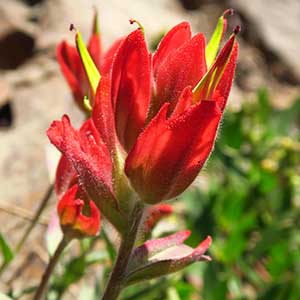Castilleja viscidula
Castilleja elmeri
sticky Indian paintbrush, sticky paintbrush
Elmer's Indian paintbrush, Elmer's paintbrush, Wenatchee Indian paintbrush, Wenatchee paintbrush
several, ascending to erect, decumbent at base, unbranched, sometimes branched, hairs spreading, long, soft, mixed with shorter stipitate-glandular ones.
solitary or few to many, erect to ascending, sometimes slightly curved at base, unbranched, rarely branched, hairs moderately dense, spreading, medium length, soft, mixed with shorter eglandular and stipitate-glandular ones, at least on distal 1/2 of stem.
green to brown, linear, linear-lanceolate, lanceolate, or oblong (narrowly ovate nearing inflorescence), 1–4(–5) cm, not fleshy, margins wavy, flat or involute, (0–)2(–5)-lobed, apex acute;
lobes ascending-spreading, oblong to narrowly lanceolate, apex acute or obtuse.
green, rarely purple-tinged, linear-lanceolate, sometimes linear or lanceolate, 1.3–6.5 cm, not fleshy, margins plane, flat or involute, entire, apex acute.
2–14 × 1–3.5 cm;
bracts proximally greenish to greenish brown, distally pale yellow, cream, or yellow-green, sometimes yellow-orange or red (sometimes gradually differentiated from proximal coloration), lanceolate, broadly lanceolate, or oblong, 3(–5)-lobed, proximal wavy-margined;
lobes ascending, linear to narrowly lanceolate, long, arising near or above mid length, sometimes wavy-margined, apex acute to rounded.
2.5–9 × 1.5–3 cm;
bracts red, crimson, scarlet, pink, magenta, red-orange, burnt orange, orange, pale yellow, or whitish throughout, or proximally greenish, distally as stated above, oblong, narrowly obovate, elliptic-oblong, or narrowly ovate, 0(–5)-lobed, rarely with 1 or 2 pairs of short, usually distal lobes;
lobes ascending, lanceolate, very short, arising from distal edge, apex rounded to obtuse.
0 mm.
straight, 16–22(–25) mm;
tube 10–15 mm;
beak exserted, straight to sometimes curved, adaxially green to yellow, 5–8(–9) mm;
abaxial lip green or yellow, sometimes deep purple, reduced, inconspicuous, often visible in abaxial cleft, 1–2 mm, 20% as long as beak;
teeth erect, green to white, sometimes yellow or pink, 0.5–1 mm.
straight, 20–33 mm;
tubes 13–18 mm;
beak, and sometimes abaxial lip, partially to fully exserted;
beak adaxially green to yellowish, 8–15 mm;
abaxial lip incurved, green, thickened, 2–3 mm, 20–33% as long as beak;
teeth ascending or incurved, green, 0.5–1 mm.
colored as bracts or proximally paler, (10–)14–18 mm;
abaxial and adaxial clefts (4–)5–9 mm, 30–40% of calyx length, deeper than laterals, lateral (1–)2–6 mm, ca. 25% of calyx length;
lobes narrowly ovate to lanceolate, linear, or narrowly lanceolate, apex acute to obtuse.
proximally green to pale green, distally colored as bracts, 15–25 mm;
abaxial and adaxial clefts 5–14 mm, 33–50% of calyx length, deeper than laterals, lateral 1–4 mm, 6–20% of calyx length;
lobes lanceolate to narrowly triangular, apex rounded to obtuse.
= 24, 72.
= 48.
Castilleja viscidula
Castilleja elmeri
Castilleja viscidula is a member of the complex including C. applegatei and C. martini, centered in California. Castilleja viscidula favors isolated mountain ranges, from the Wallowa and, possibly, the Blue mountains of northeastern Oregon, eastward into southwestern Idaho, and southward into central Nevada. Most populations are greenish yellow, but in one portion of the Wallowa Mountains, reddish bracted plants are common. Many yellowish bracted populations in the same mountain range surround this reddish population. Intermediate color forms are rarely encountered. Most ranges where C. viscidula occurs have generated slightly differing local races, demonstrating some reproductive isolation and divergence. In addition, hybrid swarms between this species and C. nana are known from several mountain ranges in central and northern Nevada, and an apparent hybrid with C. flava var. flava is known from the Independence Mountains of northern Nevada.
(Discussion copyrighted by Flora of North America; reprinted with permission.)
The bracts and inflorescences of Castilleja elmeri can be red, crimson, scarlet, pink, magenta, red-orange, burnt orange, orange, pale yellow, or whitish. While the coloration is highly variable between local populations, it is usually uniform and consistent within them. It is found primarily in the Wenatchee Mountains of Washington, where it is often on serpentine, but it ranges northward in the Cascades into extreme southern British Columbia, apparently on non-serpentine substrates. Hybrids with C. miniata var. miniata, C. parviflora var. albida, and C. thompsonii have been found in the eastern Cascades of Washington, and a similar hybrid swarm with C. thompsonii is reported from southern British Columbia.
(Discussion copyrighted by Flora of North America; reprinted with permission.)


